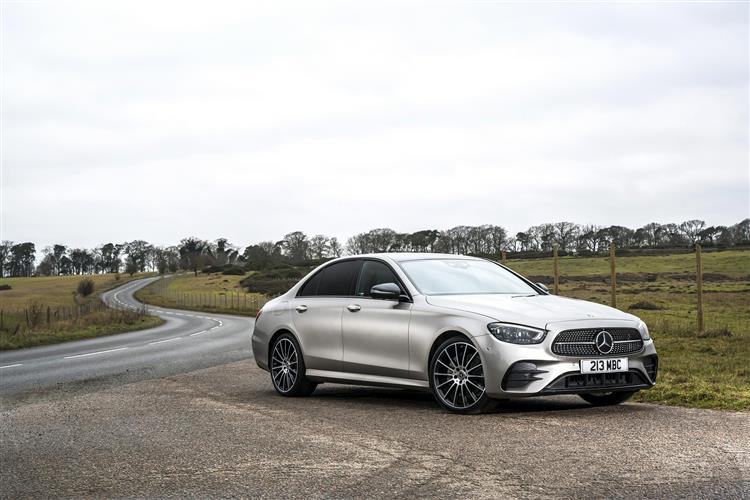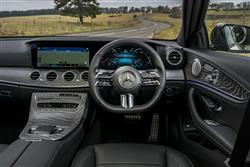MORE E FOR EFFORT (some text hidden) --NONE--
By Jonathan Crouch
Introductionword count: 117
Cars are rarely as crucial to their makers or buyers as this E-Class model always has been to Mercedes. This full-sized Executive segment contender has long been the backbone of the German company's range and a perennial favourite of the corporate car park. In 2020, improved Saloon and Estate versions of the fifth generation 'W213'-series model retained a sensible side but dialled up the desirability, aiming to offer a smarter, more prestigious approach to Executive class motoring than close competitors. They did so with more efficient engines, cutting-edge drive technology and comfort that made original customers question the need for a larger luxury saloon. Rivals from Audi, BMW and Jaguar had quite a benchmark to aim at.
Modelsword count: 29
4dr Saloon / 5dr Estate (2.0 diesel [E220d] / 3.0 diesel [E300d/E300 de/E400d] / 2.0 petrol [E200] / 3.0 petrol [E400/E 53 AMG] / 4.0 petrol [E 63 AMG])
Historyword count: 551
No car epitomises what Mercedes-Benz stands for better than the E-Class. Here, we look at a significantly updated version of the 'W213' model we first saw in 2017, which found over 1.2 million global customers in its first four years on sale before we saw the much improved version of this design in 2020, the car we're going to look at here. And a model which aimed to bring a touch of S-Class to the brand's core full executive contender. The E-Class of course, has quite a history. Back in 2020, Mercedes believed this to be the tenth generation version of this car, though by then there had only actually been five designs in this model line badged 'E-Class', the first of them launched back in 1993, which was merely an updated version of the 'W124'-series model launched seven years earlier. A proper redesign, the 'W210' model, followed in 1996, then a 'W211' series model in 2003 and a 'W212'-series design in 2010, the direct predecessor of the 'W213'-series design launched in 2017. The roots of this model line though, really stretch way back to 1953 and an original 'W120'-series 'Ponton' design widely regarded as the company's first truly modern vehicle. Some at Mercedes put the start of this model line even further back to 1946 and the post-war launch of the 170V saloon. Wherever your starting point is for E-Class heritage, there's lots of it, initially through illustrious models like the 'W114' of the 'Sixties and Seventies (which introduced diesel engines and a Coupe body style option) and its successor, the 'W123' (which established a reputation for quality and sold into the Eighties). Throughout, the car we now know as the E-Class stayed resolutely modern, pioneering everything from safety passenger cell technology to turbo induction for diesel engines. Which is the kind of innovation that continued here in this revitalised 'W213' series model. That was essential of course. When your rivals include cars as good as the Audi A6, the BMW 5 Series and the Jaguar XF, you can't afford not to try and set the standard. By 2020, all three of those cars had been fundamentally improved, hence the need to introduce this significantly updated version in mid-2020. A lot was different here, but most of it you couldn't see. Under the skin sat a totally overhauled electrical system, which not only provided for a wider range of driver assist functions but also allowed certain engines to adopt the brand's EQ Power 48V mild hybrid tech. There was also a fresh level of cabin media technology. And subtle visual changes that reflected current Mercedes styling trends. As before, customers could have their E-Class in a variety of forms, including Coupes and Cabriolets, but the core of the range was still made up by the Saloon and Estate variants we're going to focus on here. We've completed separate E-Class used Reviews on the Estate body style, the E 53 performance model and the E 300de EQ Power plug-in diesel hybrid, so search for those if you're after those specific variants. Otherwise, stick with us here as we cover the Saloon and Estate E-Class range in Car & Driving's usual comprehensive detail. The 'W213'-series E-Class range sold until mid-2023, after which a new sixth generation version of this model was launched.
What You Getword count: 734
One of the defining aspects of automotive design lies in creating styling characters so brand-specific that badges are hardly needed. This 'W213'-series E-Class model always delivered that; it could only be a Mercedes. But what kind of Mercedes? You might have expected the changes made as part of this mid-term facelift to take it aesthetically closer to its larger S-Class stablemate. Instead, the styling updates added to the Saloon and Estate variants we're focusing on here actually positioned these body styles visually closer to the next model down in the range, the 'W206'-series C-Class. This remained though, a stylish piece of design, the powerfully-extended silhouette characterised by short overhangs, a long wheelbase, large wheels and taut, well-defined flanks. Broad shoulders sit above the wheel arches and the profile is defined by a powerful waist-level swage line that flows from front to rear through the door handles, while a further crease lower down sits above a distinct sill line to give the flanks some shape. The alternative Estate version adds 10mm of length and both body styles in this revised form gained revised aero-influenced wheels, rims ranging from 17 to 20-inches in size. We should get to the update changes made as part of this mid-term facelift. There were certainly quite a few of them, as owners of earlier pre-2020-era 'W213'-series models will note at the front. The swept-back power domed bonnet flows down into a grille that was turned upside down, in this revised form being wider at the bottom than the top; a little disappointingly, it was now no longer possible to have it with an upstanding bonnet ornament. The LED headlights flanking the grille were different too - and, in pricier 'AMG Line'-series variants featured Mercedes' MULTIBEAM tech with 84 individually controlled LEDs and integrated daytime running lamps. These top models also gained a bumper closer to the more assertive style of that used by the Mercedes-AMG performance versions, which gained more overt corner cut-outs characterised by twin strakes on either side. It was even more different at the rear - or at least it was with the saloon body shape anyway, which gained much wider, horizontally-orientated LED tail lamps that got segmented by a restyled boot lid and sat above a revised bumper. And inside? Well take a seat up-front and if you're familiar with the original version of this 'W213'-series E-Class design, at first glance, there won't seem to be too many improvements over what went before, but delve into the detail and you'll find that quite a lot's different, thanks to the change to the brand's more sophisticated MBUX multimedia system, physically evidenced by the switch to a centre console-mounted touchpad interface. The multimedia colour display that helps to control this pair of bonded 12.3-inch monitors was standard across the range and could also be activated by touchscreen or the provided 'Hey Mercedes' voice-activated functionality. Also improved was the steering wheel, enhanced to be a capacitive touch-sensitive design incorporating a restyle that allows for two separate bars of switchgear to be installed along the two horizontal spokes. The dash and fascia design doesn't have the dramatic, futuristic appeal of the seventh generation S-Class of this period, but at first glance, there's much the same feeling of opulence and quality. Plus the powered, heated leather seats are perfectly contoured and fitted around the driver to give ample comfort during long trips. In the rear, the first thing you find inside is more than ample space - again, no great surprise given this E-Class model's private hire popularity, though head room might be a touch tight for those over 6 foot. If the front passengers have their seats at the lowest setting, you might find room for your feet slightly limited, but otherwise the rear footwells are big and broad, plus there are pronounced knee room cut-outs in the front seat backs. Let's finish with a look at trunk space, rated at 540-litres for the Saloon model - an unbeaten figure in the class for the period - though that falls to just 370-litres if you opt for a Plug-in hybrid variant. A standard 40:20:40 split-folding backrest allows you to extend the boot area if need be. The alternative Estate body style remains the most spacious in the segment for this period, offering 640-litres of boot space in conventionally-engined form, which can be extended to 1,820-litres by folding the rear bench.
To see the full road test text contact us on 0330 0020 227
Pictures (high res disabled)

.jpg)
|
.jpg)
|
.jpg)
| |||
.jpg)
|
.jpg)
|
.jpg)
| |||
.jpg)
|
.jpg)
|
.jpg)
| |||
.jpg)
|

|
Scoring (subset of scores)
Category: Luxury Saloons and Estates
| Performance | |
| Handling | |
| Comfort | |
| Space | |
| Styling, Build, Value, Equipment, Depreciation, Handling, Insurance and Total scores are available with our full data feed. | |



